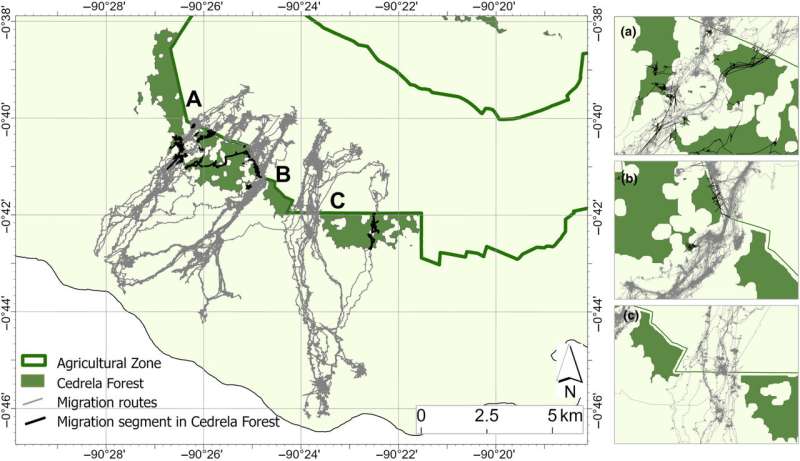Map of the southwestern flank of Santa Cruz Island, Galapagos, showing Cedrela forest distribution (dark green) and 140 Western Santa Cruz tortoise migration routes (gray tracks). Black tracks are migration route segments that pass through Cedrela forest. The three gaps in Cedrela forest cover are labeled A, B, and C. Inserts to the right of the main figure illustrate the detail of tortoise tracks in relation to the three gaps in Cedrela forest cover. Credit: Ecology and Evolution (2024). DOI: 10.1002/ece3.10994
An international team of wildlife researchers has found that the giant tortoises living on the Galápagos islands may be in danger of losing a major food resource due to the encroachment of invasive Cedrela odorata trees.
In their paper published in the journal Ecology and Evolution, the group describes their 15-year study of the migration patterns of the tortoises on Santa Cruz Island.
Prior research has shown that invasive Cedrela odorata trees have made their way to virtually all the Galápagos islands and have been described by researchers as devastating to native ecosystems. Because they grow close together and form a type of bramble, they overtake native plants, resulting in drastic effects on local wildlife.
One animal affected is the Western Santa Cruz tortoise, a giant tortoise that migrates inland from areas near the sea during certain times of the year. Prior research has shown that the tortoises migrate to find food during the dry season. Such migrations typically involve climbing uphill into the highlands, where food is more plentiful. But in recent years, the tortoises' path to the highlands has become increasingly blocked by Cedrela forests.
Over the past decade and a half, the research team has been watching and charting the paths taken by the tortoises. They found that when the massive creatures encounter the forest, they become entangled and endure painful pricks. Most turn back. The tortoises have looked for ways around the forests, but there are few options. Currently, there are only three gaps, forcing all the tortoises to use the same routes.
The researchers note that forest encroachment is continuing on Santa Cruz Island, suggesting it is possible that all of the gaps that now exist will close, leaving the tortoises no way to get through. If that happens, they suggest, the tortoises will have to survive on a suboptimal diet, which could adversely impact their health, lead to growth problems, and perhaps stunt reproduction efforts.
They note that this would have other impacts as well—during their migrations, the tortoises spread seeds, helping to preserve diversity. They also turn up the soil as they walk and clear away small plants, making way for new growth.
More information: Stephen Blake et al, Invasion by Cedrela odorata threatens long distance migration of Galapagos tortoises, Ecology and Evolution (2024). DOI: 10.1002/ece3.10994
Journal information: Ecology and Evolution
© 2024 Science X Network
























